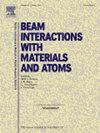Damage and degradation region of GaN HEMTs induced by different radiation effects
IF 1.4
3区 物理与天体物理
Q3 INSTRUMENTS & INSTRUMENTATION
Nuclear Instruments & Methods in Physics Research Section B-beam Interactions With Materials and Atoms
Pub Date : 2025-02-11
DOI:10.1016/j.nimb.2025.165635
引用次数: 0
Abstract
With the increasing demand for higher power density and operating frequency in modern power systems, traditional semiconductor power devices are approaching their material limits. Consequently, there is a growing need for a new generation of semiconductor devices. Gallium nitride (GaN) is widely regarded as the primary candidate material for the next generation of power devices, with AlGaN/GaN HEMTs developed using it as the core material attracting increasing attention. This work aims to summarize the impact of different radiation effects on GaN HEMTs in various scenarios, including radiation damage mechanisms, vulnerable areas, and electrical degradation. Furthermore, this work highlights the potential development trajectory for enhancement mode devices through previously proposed radiation hardening schemes.
不同辐射效应对GaN hemt损伤及降解区域的影响
随着现代电力系统对更高功率密度和工作频率的要求越来越高,传统的半导体功率器件正在接近其材料极限。因此,对新一代半导体器件的需求日益增长。氮化镓(GaN)被广泛认为是下一代功率器件的主要候选材料,以其为核心材料开发的AlGaN/GaN hemt越来越受到关注。本工作旨在总结不同辐射效应在不同情况下对GaN hemt的影响,包括辐射损伤机制、脆弱区域和电退化。此外,这项工作强调了通过先前提出的辐射硬化方案增强模式器件的潜在发展轨迹。
本文章由计算机程序翻译,如有差异,请以英文原文为准。
求助全文
约1分钟内获得全文
求助全文
来源期刊
CiteScore
2.80
自引率
7.70%
发文量
231
审稿时长
1.9 months
期刊介绍:
Section B of Nuclear Instruments and Methods in Physics Research covers all aspects of the interaction of energetic beams with atoms, molecules and aggregate forms of matter. This includes ion beam analysis and ion beam modification of materials as well as basic data of importance for these studies. Topics of general interest include: atomic collisions in solids, particle channelling, all aspects of collision cascades, the modification of materials by energetic beams, ion implantation, irradiation - induced changes in materials, the physics and chemistry of beam interactions and the analysis of materials by all forms of energetic radiation. Modification by ion, laser and electron beams for the study of electronic materials, metals, ceramics, insulators, polymers and other important and new materials systems are included. Related studies, such as the application of ion beam analysis to biological, archaeological and geological samples as well as applications to solve problems in planetary science are also welcome. Energetic beams of interest include atomic and molecular ions, neutrons, positrons and muons, plasmas directed at surfaces, electron and photon beams, including laser treated surfaces and studies of solids by photon radiation from rotating anodes, synchrotrons, etc. In addition, the interaction between various forms of radiation and radiation-induced deposition processes are relevant.

 求助内容:
求助内容: 应助结果提醒方式:
应助结果提醒方式:


